Ever since Willum has had his 1986 Toyota Pickup, the coolant temperature gauge has never indicated whether the engine has warmed up. The needle would rarely move off the peg. Logic would tell you that either the gauge is broken, or the thermostat was stuck open. Since most of the parts on the truck looked to be original, replacing components of the cooling system was a step in the right direction.
Pregaming
Before we embarked on replacing parts on the truck, we ran a coolant flush through the system. The concoction comes in a small bottle and is poured directly into the radiator. Will said it looked like water, but I’m fairly certain the skull and crossbones logo means it won’t quench your thirst. For our uses, we poured the entire bottle into the radiator and drove it around for an hour running errands to make sure the cleaner had a chance to circulate throughout the entire engine.
With our errands done, it was time to start taking things apart. The factory skid plate had to be removed first, then we could move towards draining the old coolant. We loosened the radiator drain petcock and out came Starbucks’ new Mountain Dew flavored coffee. Despite the radioactive hue, this was a good sign as it radiator flush contents had worked. The next step was to undo the radiator hoses and let the remainder of the system drain. We also ran additional water through the block to make sure everything was flushed out completely.
-
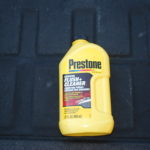
-
The cocktail of choice for flushing the system.
-
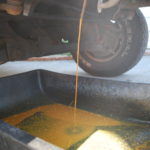
-
This is the result of draining the old coolant…tasty.
Out Comes the Toolbox
Toyota made removal of the Pickup’s radiator very straight forward. There’s four bolts that hold the the plastic fan shroud to the radiator. Once those bolts are removed, the shroud can be lifted out, even with the fan in place. To undo the radiator itself, there are four more bolts that mount the unit to the front end. It’s suggested to do the bottom bolts first and work your way to the top ones, because there will be nothing supporting the radiator and it’ll drop if you’re not ready for it.
The likely problem child of this operation (the thermostat) lives at the top of the block, right next to the valve cover. Two 12mm bolts secure the top housing cover before exposing the thermostat. In our case, the bolts were very stubborn, so once they broke free, we proceeded to chase the threads and clean the bolts before they were to be used again. From our parts pile we pulled out the new thermostat and o-ring to set them into position. The thermostat housing was then buttoned up with our cleaned bolts and a small side of anti-seize.
The new radiator and fan shroud went into place without a hitch. While we had everything accessible, Willum thought it was a good idea to change the belts too, so an extra 10 minutes was spent fiddling with that. The radiator hoses were slipped on and told not to move with a new set of hose clamps. We bought a few jugs of distilled water and antifreeze and started to fill up the system.
-
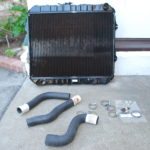
-
Here’s the host of new shiny parts to be installed: 1) Radiator 2) Coolant Hoses & clamps 3) Thermostat & O-Ring
-
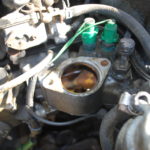
-
Just left of the valve cover is where the thermostat housing is located. Here it is with the top cover unbolted and the old thermostat removed.
-
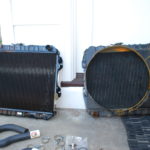
-
Meet the new boss, same as the old boss…
Losing its Cool for the Better
The truck’s motor was fired up, and the cooling system began to rid itself any air bubbles. We took the truck for a spin around the neighborhood to make sure everything was functioning as intended. To our surprise, the temperature gauge started to move. This concludes the theory that the old thermostat was at fault. The gauge settled around the 1/3 mark and that’s where it remained. Around town accelerator response seems to have improved a bit with the engine actually up to temperature. Keep in mind that this truck has a carburetor, so it needs ample time to get the juices (go-juice to be precise) flowing. We may even see an improvement in gas mileage since a warmer engine runs more efficiently, but that’ll require some simple math next time the tank is filled at the gas station.
-
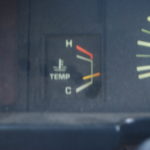
-
Great News! The gauge actually works!
-
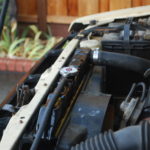
-
Even if it does nothing better than the old one, at least the new radiator looks spiffy.
This project was far from a performance mod, but sometimes simple maintenance goes a long way. With fresh coolant flowing through the engine and the thermostat working, the old 4×4 was issued a clean bill of health. Let the next round of adventures begin.
-JC

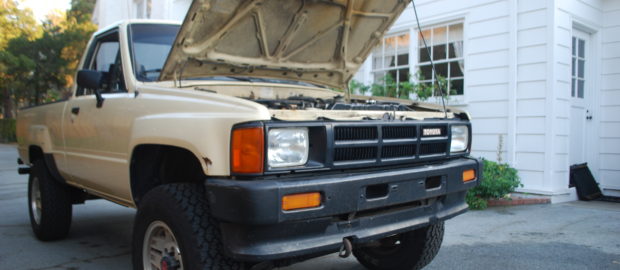










![[Project Toyota 4×4] Transition of the Transmission](https://drivewerks.co/wp-content/uploads/2017/03/IMG_20170309_170158-140x90.jpg)
![[Project Toyota 4×4] It was all in your Header](https://drivewerks.co/wp-content/uploads/2016/11/IMG_20161127_161318-140x90.jpg)






